Introduction
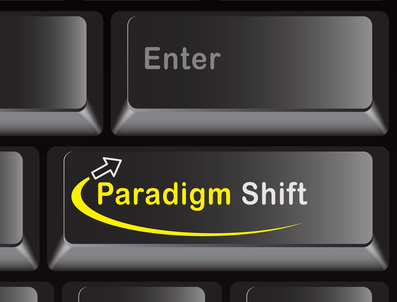 There is an exciting paradigm shift happening within the information systems (IS) field. This means a new breed of information systems is emerging as are new approaches for developing them. The good news is that business analysts may be more critical to the new paradigm than to past ones.
There is an exciting paradigm shift happening within the information systems (IS) field. This means a new breed of information systems is emerging as are new approaches for developing them. The good news is that business analysts may be more critical to the new paradigm than to past ones.
A paradigm shift is a subtle but important change from one way of thinking to another. It's a revolution, a transformation, a sort of metamorphosis. It doesn’t just happen, but rather a strong impetus for change drives it. The two major areas for change driving the new IS shift are the desire or need to:
(1) manage business process and business rules as separate but closely related and connected resources and
(2) decompose software or programming code into reusable modules, called services, managed by a service oriented architecture (SOA) infrastructure. The SOA infrastructure manages and mediates services used in a business process.
Research and practice proves that a successful paradigm shift cannot happen without training and educating those in the middle of it. Lack of training and education is currently impeding the current IS paradigm shift. There is a shortage in today’s enterprises of people trained in business process, rules management, and SOA. Part of the reason for this educational deficit, is that IS academic programs are slow to respond to the serious changes occurring in most industries today.
This article has three outcomes. The first is to provide an overview of the new breed of information systems including what a business analyst needs to know and what acorresponding academic or training curriculum needs to include. The second outcome is to demonstrate how one undergraduate IS academic program has addressed the major changes driving this paradigm shift. The third outcome is to provide references for readers interested in getting thetraining and skills to be successful in the new IS paradigm.
Early Information Systems
Early information systems were developed as one complete programming entity that included the business process, business logic, and data management functions mixed together. In the 1960s, database management systems appeared that managed data as a resource separate from the process and logic. Managing data separately created a number of amazing benefits. The major ones are: shared and easier access to data, more system adaptability due to data independence, and better data integrity. One critical benefit often overlooked is that database management systems deliver direct access to data, through easy-to-use query languages, to business users.
However, the navigational database management systems of the 1960s were not very effective because they were designed for use primarily by IT professionals and not by business folks. Thus, the separation of data alone did not deliver on the total promise of effective data management. Total effective data management became possible only with the adoption of the relational data model in the 1970s. The relational data model is technology-independent which means it is independent of how and where it is executed and whether automated or not. It created a new level of conceptualization that allowed the business folks, not just IT professionals, to understand, use and manage data. That is when the paradigm shift in the data world became real.
Thus, starting in the 1970s, information systems were developed with a database-driven focus illustrated in Figure 1. The data component of the system was developed and implemented using a relational database management system. The application or business logic was programmed in the COBOL programming language. Today the most common programming languages are Java and C++.
Figure 1: Database-Driven Information Systems
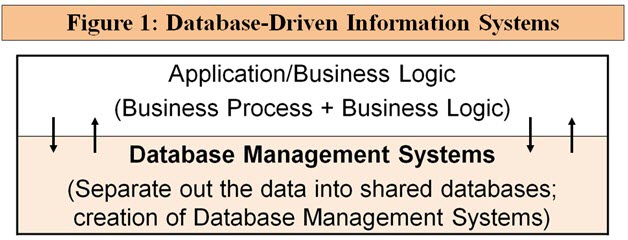
A Typical Undergraduate Information Systems Academic Program Prior to the New Paradigm
The Management Information Systems (MIS) program in the Terry School of Business at the University of Georgia (UGA) is a representative framework of a typical IS academic program. The MIS major at the University of Georgia builds on the Terry College of Business common business core, which includes course work in accounting, economics, business law, mathematics, statistics, information systems, finance, marketing, production, and management. Often students complete the common core before taking course work in the MIS program.
The UGA MIS program equips students with the tools for "leading IT-enabled change in organizations." MIS students typically find careers as consultants or business analysts. The Terry MIS program provides the foundation for students to go in a technical direction (such as a programmer or database administrator), a non-technical direction (such as a business analyst or project manager), or somewhere in the middle (such as a business intelligence or IT risk and security specialist).
The MIS Department has 11 full-time and 3 part-time faculty members. There are 250 undergraduate MIS majors and 60 students in the Masters of Internet program. MIS courses are also taught in the full-time and part-time MBA programs. In addition, the Department has six PhD students. MIS students have some of the highest placement, internship, starting salaries, and job satisfaction rates of any major in the Terry College. The Terry MIS program is ranked among the top 15 in the U.S., and the faculty is world-renowned. MIS is a hands-on major which equips students with real-world skills that are in demand in the job market.
As with any IS academic program developed in the last 40 years, the UGA MIS program has focused on the design, development and implementation of the database-driven information systems shown in Figure 1. This database-driven focus is reflected in UGA MIS curriculum up until 2008 (see Figure 2). Note there are four required courses and three required electives. In the Terry College of Business, majors are limited to seven courses. The two required programming courses deal with the development, testing, and implementation of business logic in the information system. While the database course deals with the data management aspects of the information system, the remaining required course deals with the overall perspective of business analysis and systems development. The two bolded electives in Figure 2, business process management and project management, were implemented as electivesin 2007 when the MIS Department recognized that major changes were taking place in the field requiring an innovative response.
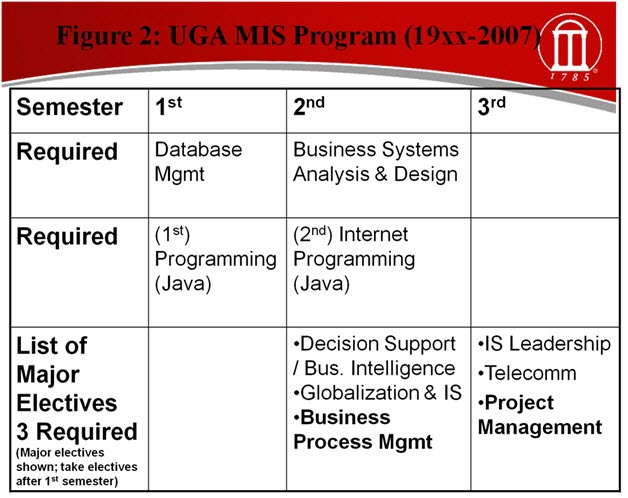
The core courses in Figure 2 reflect those needed by a business analyst when the dominant type of system was a database-driven system: database management, programming, Internet basics,and business and system analysis and design skills. In the emerging paradigm, database management skills remain critical but other core skills are becoming central to the preparation of future business analysts and MIS professionals. This emerging paradigm is the heart of this article.
The Changing Paradigm: the New Breed of Information Systems
As mentioned above, two major areas for change that are driving a new breed of information systems are the desire or need to:
(1) manage business process and business rules as separate resources but are closely connected; and
(2) decompose software or programming code into reusable modules, call services, and managed by a service oriented architecture (SOA) infrastructure.
These changes are creating Process-Based Information System depicted in Figure 3. Similar to what happen with data 50 years ago, the business process is separated and managed by a Business Process Management System (BPMS) and the business rules (business logic), are separated and managed by a Business Rules/Decision Management System (BRMS/BDMS). Within this new type of system, the application is the business process actually executed by the BPMS, as shown in Figure 3. During execution, the different services assigned to activities in the business processare executed and may be a task (application logic), rule/decision and/or database service. The SOA infrastructure manages and mediates services used in the business process.
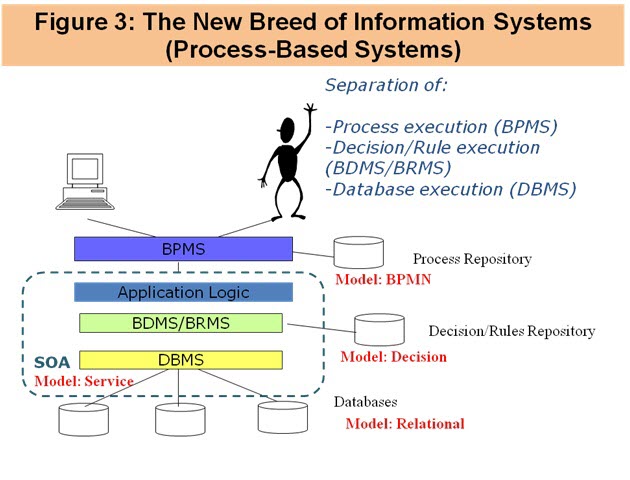
BPMS and SOA
A BPMS is a platform for developing, running and managing business process oriented information systems. On one hand, it is a development platform for creating information systems without programming. The BPMS provides a software environment that allows the user (e.g., business analyst) to model and improve business processes. Many refer to the systems created by BPMS as composite or process-based applications/systems because the user is composing the application instead of building or buying it. The user composes the application or system by selecting existing services and assigning them to activities within the business process which is then executed by the BPMS. The analogy for this would be using Lego blocks to create a toy structure. Lego bricks can be assembled and connected in many ways, to construct such objects as vehicles, buildings, and even working robots. Anything constructed can then be taken apart again, and the pieces used to make other objects. Thus, a BPMS is a platform for developing process-based systems and a platform for executing these systems in real-time and monitor the results.
The key to business process management, whether taking a business management or technical perspective, is the development of a good process model. A process model (e.g.,order process) captures the sequences of activities (get customer information, determine order and discount amounts, compute taxes, etc.) from the initiating event of a process (customer order is entered) to a defined end state (success [order shipped] or exception [order denied due to bad credit]). The process model is a map of all possible paths from the initiating event to all possible end states. It is not just a diagram; its purpose is to convey meaning. From the diagram alone, the process logic should be clear enough and understandable to a business person to be useful for managing the business process while also being semantically precise enough, as required by technical personnel (business analyst developing requirements for a system) or a software system (BPMS) from which to develop and execute the application/system.
For years many different flowcharting representations captured business processes. However, resulting flowcharting diagrams were not sufficient for capturing the complexity of a business process to be easily understood by business folks and yet precise enough to describe technical details for process execution in a BPMS (Silver, 2011). An example of the limited capabilities of the flowchart model is its inability to model event-triggered behavior such as a customer canceling an order. Such event-triggered behavior happens all the time but is not easily modeled in a flowchart. As with early database management systems, these flowcharting systems weremainly an IT tool, not intended for business people. Thus, for the new IS paradigm to become real, a new more powerful process modeling language was needed.
The answer came with BPMN, Business Process Model and Notation. BPMN is a graphical powerful diagramming language for business process flows. The most important benefit of BPMN is that it is a standard, maintained by the Object Management Group (http://www.bpmn.org/). This means that the language is not owned or controlled by a single company, but rather that it is managed by a group of representatives from different interested companies including software vendors and consulting companies. The first approved specification, BPMN 1.0, was adopted in February 2006. Since then, there has been BPMN 1.1, 1.2 and the latest specification BPMN 2.0, proposed in January 2011. Today, virtually every process modeling software tool supports BPMN in some fashion although only a few have implemented BPMN 2.0. For those readers wanting to learn more about BPMN see Silver (2011).
A key benefit of a process modeling standard is that process models can be shared between software tools, and thus, users of different tools can understand models created in a tool that they are not currently using. The semantics and the notation are defined by the standard, not by each tool. BPMN is a rich language, able to describe the complexities of a business process compactly in a diagram. BPMN is also able to describe process meaning in enough technical details to enable process execution in a BPMS. Thus, BPMN provides a bridge between the worlds of business and IT through the use of a common process language that can be used to develop shared models used by both groups.
As stated earlier, in the new IS paradigm, a designer/analyst composes the application or system by selecting existing services and assigning them to activities within the business process which is then executed by the BPMS. This is where SOA (Service-Oriented Architecture) and BPMS work together. SOA is a set of architectural principles that leverages open standards to represent software applications as services. The fundamental principle is that each software application in the system is a service. Thus, individual software assets, services, become building blocks that can be reused in developing applications. The preferred method of implementing a SOA is Web services. The preferred way of deploying SOA is an Enterprise Service Bus.
The relationship between a BPMS and the SOA infrastructure is capture in Figure 4. One of the principles of BPMS design is to expose the BPMN process logic in a layer separate from the services used in the execution of that process. The BPMS manages the process-related activities while the SOA infrastructure manages and mediates the services used in the business process.
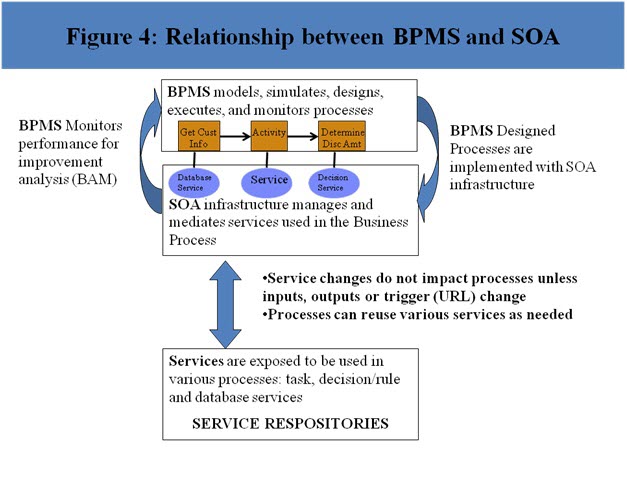
The service model provides the fundamental building block for developing systems in the new IS paradigm as shown in Figure 3. Each service is treated as a black box (encapsulated) by the BPMS. To use a service, the analyst/composer only needs to know the inputs and outputs for the service and how to access or trigger the service (usually a URL). For example, the first of the three activities displayed in Figure 4, which is part of larger order fulfillment process, might be to access the customer database to retrieve customer information. To implement this activity, an analyst enters into the BPMS the URL for the database service specifying inputs (customer number) and outputs (desired customer information) for that service. Composite design is implemented, simply by selecting the services and specifying location (URL), inputs and outputs. When the BPMS executes this process activity, the URL will be used to locate the service and then the SOA infrastructure will manage and mediate the execution of that service. Besides being treated as a black box, a service is platform and location independent. Location independent means that the service can exist anywhere on the Internet. Platform-independent means that the software service can be developed in any programming language. Since any software asset can be set up as a service or to act like a service, in the new IS paradigm all available software assets can be utilized as building blocks in the development and execution of process-based information systems.
Business Rules and the Decision Model
In Figure 3, the new breed of system has the option to separate business logic/rules and manage them separately using a Business Rules/Business Decision Management System (BRMS/BDMS). The focus is on separating business rules that are shared among systems, ones that are likely to change, or ones that are important for business people to see and know. In general, this is any business logic that business folks would like to manage in the system, but over which they want to retain business governance. The rules are created in a representative structure or language of the BRMS/BDMS and stored in a rule repository. Rules are invoked by a software application (BPMS) and executed by a business rules engine/server component of the BRMS/BDMS. These systems also provide tools for testing and simulating business rules and making rules available for run time adjustment by business users.
Using BRMS/BDMS provides a number of benefits: system agility (making changes quickly), better business-IT alignment, compliance, efficiency, continuous improvement, consistent decision-making and knowledge retention. These benefits all support the most important motivation for separating out business logic which is to enable business leaders to manage business logic for the good of the business. The separation of the business process discussed in the previous section also provides similar benefits and motivation for the management and execution of a business process.
BRMS have been around since the 1990s. Yet, they are not in widespread use, and thus, the separation of business rules has really not been very successful. One might wonder why this is the case given the many benefits of separation? To answer this, review the earlier discussions on the relational data model and BPMN process model. In both cases, separation alone did not deliver on the promise of effective data or process management. Effectiveness in these areas (and hence, new paradigms) became possible only with the adoption of the relational and BPMN models. BRMSs were primarily developed for and used by IT people and their primary level of modeling is at the individual rules and rule group level. This level of modeling is at the wrong level of abstraction and specificity for business (and business analyst) audiences.
It is clearly useful to separate business logic but to do it effectively a new level of abstraction, a new model, for managing business rules/logic is needed. Based on the experience with data and process models, this new model needs to be technology-independent and have the ability to bridge the business and IT communities. von Halle and Goldberg published a book in 2009 outlining in depth the type of model needed, referred to as the Decision Model. It defines a technology-independent way of organizing and modeling business logic in terms of decisions and sets of business rules (rule families) that go into making a decision. It has a graphical notation for providing a high-level view of the decision and the relationships among rule families that make up the decision. This Decision Model is a pure representation of business logic independent of biases from process, data or technology. For more information on the decision model, see von Halle and Goldberg book (2010) and the tutorial article and other resources at the KPI website.
Despite being independent of technology, the Decision Model is easily implementable in technology, applicable to both current and future technology products. Decision Model concepts have already found their way into the rule management, RuleGuide (http://www.newwisdomsoftware.com), and BDMS software, OpenRules (http://openrules.com/). A full decision modeling and execution BDMS, based on the Decision Model, was released in late 2011, Sapiens Decision (http://www.sapiensdecision.com/).
The strength of the Decision Model is reflected in the speed of its implementation into technology, the rapid growth of successful applications of it in a number of cases. At the same time, the OMG has initiated a subcommittee called DMN (decision model notation) Group.
Before giving a brief example of how a BDMS (Business Decision Management System) works, it is helpful to understand how business rules and business process relate. Historically, business rules or parts of them were treated as pieces of the business process and embedded in the process model itself. This very common practice leads to complex business processes that are difficult to understand and manage and to business rules and logic that become impossible to maintain. Thus, it is critical in process modeling to identify those process tasks that make a decision and treat this decision as separate activity, not part of the business process. The business logic behind each such decision is modeled separately using the Decision Model.
For a brief example of how the Decision Model relates to a business process, revisit the three activities within a larger customer order fulfillment process illustrated in Figure 4. Assume the third activity denotes a decision task to determine discount amount. (Note that the business analyst was a good process modeler and separated out the decision into a separate activity.) The business analyst then develops a decision model for determining the discount amount decision. The analyst discovers that the decision is based on a set of rules or logic containing conditions about discount rate and order amount. The discount rate is determined by a set of rules that contain conditions involving customer classification and order amount (sample rule: If customer classification is “Gold” and order amount is between 500-2001 then the discount rate is .07). Customer classification is determined by a set of rules that contain conditions involving credit score and amount spent YTD.
A decision model represents these three sets of rules rule families represented in a graphical model showing the relationships among them. Developing, validating the integrity, and testing a complete decision model occurs in a BDMS such as Sapiens DECISION. Once the model is tested and deemed ready to use, the BDMS (depending on target automation technology) creates the code behind the decision service that would take order amount, credit score and amount spent YTD as inputs and deliver discount amount as an output. A URL is created for accessing the service. The decision service could then be used by the order fulfillment process (or any other process) by simply specifying the URL, inputs and output for this service when the BPMS activity is designed. When activity three is executed in the example process, the BPMS would use the URL to execute the decision service. Another advantage of the Decision Model is the ease in which analyst/designer can use the model or parts of the model to create decision services that can be executed by any process-based information system. An advantage of a BDMS is that the same decision model can be deployed in multiple automation technologies, if necessary.
What Business Analysts need to Know to Work within the New IS Paradigm
The previous sections outlined and discussed the paradigm shift from developing the traditional database-driven systems (see Figure 1) to developing and executing process-based information systems (see Figure 3). This final section summarizes what business analysts need to know to work with process-based information systems. Again, the UGA MIS curriculum frames the discussion. The UGA MIS curriculum’s primary outcome is to develop business analyst skills.
The current and future UGA curriculum is shown in Figure 5. In 2008, Business Process Management (BPM) and Project Management became required courses. In 2011, the new curriculum was extended to four semesters by requiring students to take all five required courses before taking the required Business Systems Analysis and Design course. Figure 5 includes two future changes the MISDepartmentis considering. One change is allowing students to take Advanced Business Process Management or Internet Programming as a required course, currently Advanced Business Process Management is an elective course. The other change is to add an elective course on the Decision Model/Business Rules. As of the spring semester 2012, UGA MIS major is comprised of six required courses and one elective. For a detailed description of curriculum and courses,see http://www.terry.uga.edu/mis/.
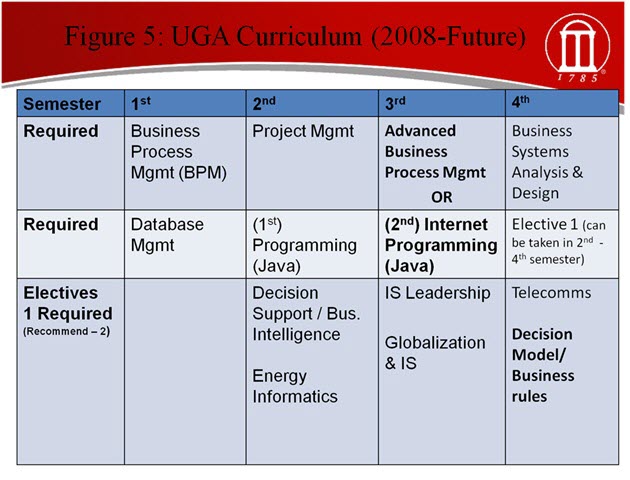
Naturally, database management remains a required core course. Business analysts still need to be solidly grounded in the relational data model, data modeling and the use of database management systems. The two programming courses also remain as required courses. Business analysts still need a basic understanding of programming, especially Java programming, thus, the required first course in programming. The basic knowledge in Java programming is helpful in using and understanding the BPMS and BDMS/BRMS tools since most of these tools were developed in Java.
The major changes for the paradigm shift to process-based information systems are in the two BPM courses.The general outcome of the first BPM course, required of all MIS majors, is to improve student’s understanding and skills in terms of modeling, improving and managing organizational work systems, especially the understanding of the process and technology components of these systems. The course focuses on BPM both as management discipline and as a technology (BPMS). In this article, the focus has been on BPMS. BPM as a management approach defines an organization as a collection of processes focused on customer satisfaction, managing process using well-defined measures, and continually improving processes. The purpose of BPMS and the other technology shown in Figure 3 is to enable more effective BPM.
The BPM course covers a gamut of topics from process management, business process analysis, modeling (BPMN) and simulation to BPMS implementation, the use of web services, and process redesign methodologies. The heart of the course is process modeling using the BPMN modeling language.
The second course, Advanced BPM, focuses on BPMS, SOA (Service-oriented architectures) and BDMS (Business Decision/Rules Management Systems) as a new environment for developing and executing process-based information systems. Students build a number of systems using a commercial BPMS_SOA_BDMS environment. SOA service model is introduced in the first course but is covered in more depth in the second course. The same is true for the Decision Model and BDMS. The business analyst needs a basic understanding of SOA principles and their implementation in Web services including the selection and use of Web services. As indicated in the previous section, it is apparent that the Decision Model is going to become the dominant model in the business rules area and BDMS the dominant technology.The basics of this model and the technology are covered in the two BPM courses. However, there is enough important material to offer a full course elective on this topic, and thus, the proposed elective course in the curriculum.
The Advanced BPM course is currently an elective in the UGA curriculum. In Figure 5 this course is shown as an optional required course because it will be included as such in the near future. The optional required course placement reflects the current state of information systems development. The new BPMS_SOA_BDMS environment provides a new development and execution platform where systems are composed based on existing services. The second programming course reflects the traditional building your own systems. This ‘built” approach will not go away but will slowly transition to building services that will be used to in composing process-based information systems instead of building application systems. In the beginning, all IS development took the “build” approach given the technology tools available. The “built” period was followed by a focus on buying applications especially for non-core systems, particularly in the form of ERP systems.
In early 2012, the companies hiring UGA MIS students are still primarily interested in ‘built” and “buy” approaches which is why we have not made the Advanced BPM an optional required course yet. As companies move into the BPMS_SOA_BDMS environment, outlined in this article, and focus shifts more fully to a “compose” approach, the Advanced BPM will become an optional requirement course allowing students to focus on “built” or “compose” approach to system development. This transition to a “composed” approach is happening quite quickly. The major roadblock is the lack of trained personnel. The Business Systems Analysis & Design course has also been modified to include this “compose” approach with the traditional “build” and “buy” system development approaches.
Wrap Up
Finally, the most important knowledge a business analyst needs to have to succeed within this new IS paradigm is an understanding of the four core models: BPMN process model, Decision Model, Relational Data Model and the SOA Service Model. These four models are all technology-independent but all are easily implemented in technology. Understanding the models provides the best mechanism for understanding and utilizing the technology that implements them. A general knowledge of the SOA Service Model is important but a detailed knowledge is not necessary because this model has many technical aspects that are not essential to the business analyst. However, a detailed understanding of the other three models (BPMN, Decision and Relational) is essential for the business analyst. The reason for this is that these three models provide critical bridges between the worlds of business and IT through the use of a common models and languages that can be used to develop shared models used by both groups.
The problem with most information systems academic programs is that they have not made the changes to implement the paradigm shift that is described in this article. Most programs look more like the one in Figure 2, rather than the curriculum we just described in Figure 5 . There are a number of training programs available to help develop the skills reflected in the courses shown in Figure 5[2] .
The new breed of information systems, depicted in Figure 3, provides the technology environment for business analysts to model and automate the essential business and decision processes which impact the quality and effectiveness of our work and our lives. As academics, business analysts, MIS professionals and business managers, we must all learn the critical models and the skills and technology necessary to move this new paradigm forward. This article has provided some first teps to facilitate the exciting information systems paradigm shift that stands in front of us.
Author : Robert Bostrom (edited by Barbara von Halle)
Dr. Bob Bostrom is President of Bostrom & Associates, an Athens-based training and consulting company focusing on facilitation and the effective integration of people and technology. For 22 years he taught and contributed significant research at the University of Georgia where he held the chaired position of the L. Edmund Rast Professor of Business. He designed and taught numerous classes in Management Information Systems (MIS), Management and Leadership for undergraduate, graduate and Ph.D students. Dr. Bostrom holds a B.A. in Chemistry and M.B.A. from Michigan State University, an M.S. in Computer Science from SUNY at Albany, and a Ph.D. in MIS from the University of Minnesota. Besides abundant publications in leading academic and practitioner journals, he has extensive consulting and training experience. His current research and consulting interests are focused on Business Process Management (BPM), high-performing individuals, facilitation, technology-supported learning, and effective design of organizations via integrating human and technological dimensions. He now holds the title of Professor Emeritus at the University of Georgia and continues to teach advance BPM courses and mentor students and colleagues.
Barbara von Halle is Managing Partner of Knowledge Partners International, LLC (KPI). She is co-inventor of the Decision Model and co-author of The Decision Model: A Business Logic Framework Linking Business and Technology published by Auerbach Publications/Taylor and Francis LLC 2009.
[1]For a listing of academic programs that have addressed this new breed of process-based information systems, see http://www.bptrends.com/resources_organizations.cfm?organizationTypeID=2F5802DD-3048-C0CF-057584B8675B9A1A.
[2]One of the best and most comprehensive is the BPM Institute training program, see http://www.bpminstitute.org/training.
References
Database Management Systems
-
For good overview, see http://en.wikipedia.org/wiki/Database_management_system
-
There are many good textbooks; the one I would recommend is Data Management: Databases & Organizations, 5th Edition, by Richard T. Watson (The Univ. of Georgia), 2006, see http://www.richardtwatson.com/dm5e/
Business Process Management Systems (BPMS) and Business Process Modeling Notation (BPMN)
-
A great introduction to BPMN by Bruce Silver can be found at http://wiki.sdn.sap.com/wiki/display/BPX/Process+Modeling+With+BPMNDelivered in six 20-minute segments of Flash video, this course explains all of the diagram patterns important to process modeling with BPMN and how BPMN is used in conjunction with executable process design.
-
Silver, Bruce, BPMN Method & Style with Implementer’s Guide, 2nd Edition, Cody-Cassidy Press, Aptos, CA, 2011 (Amazon: http://www.amazon.com/Method-Style-Edition-Implementers-Guide/dp/0982368119/ref=sr_1_1?ie=UTF8&qid=1336326893&sr=8-1) Also check his blog, BPMS Watch, http://www.brsilver.com/
-
Harmon, Paul, “Once More: What is BPM” http://www.bptrends.com/publicationfiles/advisor20100615.pdf Paul’s web site and newsletter are also a great resource http://www.bptrends.com
-
Harmon, Paul, “Where Does BPMS Fit Into BPM?, http://www.bptrends.com/publicationfiles/advisor20110426.pdf
-
BPM Basics for Dummies, http://www.softwareag.com/corporate/res/books/bpm_for_dummies/default.asp
Service Oriented Architecture (SOA)
-
Two minute video SOA overview: http://www.youtube.com/watch?v=zV860odGN5Y
-
SOA Adoption for Dummies
-
Good book covering major SOA topics: Applied SOA: Service-Oriented Architecture and Design Strategies [Paperback], Michael Rosen (Author), Boris Lublinsky (Author), Kevin T. Smith (Author), Marc J. Balcer (Author),
Business Rule and the Decision Model
-
Silver, Bruce, “Driving Agility and PerformanceWith BPM and Business Rules”, http://www.techie.techieindex.com/techie/whitepapers/wp_details.jsp?id=1786
-
The best detailed discussion of Decision Model and its relationship to other models discuss in this paper see book: The Decision Model: A Business Logic Framework Linking Business and Technology (IT Management) [Hardcover] Barbara von Halle (Author), Larry Goldberg (Author); for introduction to Decision Model, see primer article http://kpiusa.com/index.php/The-Decision-Model/the-decision-model.html (see this site for other Decision Model resources)
Other Useful Links